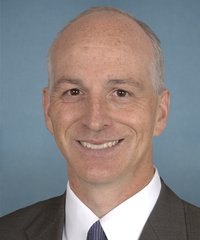
Adam Smith was born on June 15, 1965, in Washington, D.C. Adam was raised in SeaTac, Washington where his father, Ben, worked as a ramp serviceman at SeaTac Airport and was active in the local Machinists’ Union. His mother, Leila, stayed at home, raising Adam and his two brothers. Adam attended Bow Lake Elementary, Chinook Middle School, and Tyee High School, graduating from Tyee in 1983.
After a year at Western Washington University, Adam transferred to Fordham University, where he worked his way through college loading trucks for United Parcel Service and graduated in 1987 with a degree in Political Science. Following his graduation, Adam attended the University Of Washington School Of Law, and earned his law degree in 1990. He later worked in both private and public practice, first as a lawyer at Cromwell, Mendoza and Belur in 1992, and then as a prosecutor for the City of Seattle from 1993-1995. As a prosecutor, Adam focused on drunk driving and domestic violence cases, and in 1996, went on to work as a judge pro tempore.
In 2011, the problem of gun violence hit especially close to home for me when my good friend and colleague, then-Congresswoman Gabby Giffords, was shot and nearly killed when meeting with her constituents. Six other people died as a result of that senseless act of violence. This, along with many other tragedies, reinforces the need for our country to enact sensible firearm safety reform.
I am inspired by the Marjory Stoneman Douglas High School survivors and students, as well as those across the country who are speaking out against gun violence and condemning the National Rifle Association (NRA). These young people are a real force for change, and I stand with them in saying “never again.” In response to recent school shootings, some have suggested arming teachers, a misguided proposal that would only increase the risks of gun violence in schools. I am opposed to doing so because schools should be a safe haven for students. Arming teachers could create an even more dangerous learning environment.
There was absolutely no reason for the shooter in Las Vegas to be able to amass a stockpile of 47 weapons; many of them high-powered rifles. According to the Government Accountability Office, there are approximately 350 million firearms in civilian ownership – more than enough for there to be a gun for every American adult and child. The sheer number of firearms, coupled with how easily they can be obtained, results in increased accidents, self-inflicted harm, and intentional acts of violence. Reducing access to and the availability of firearms is one avenue to reducing violence, and I support gun buyback programs like those which have been successful in U.S. cities and other countries, such as Australia.
According to the Centers for Disease Control (CDC) Prevention’s National Vital Statistics System in 2016, the year for which the most recent data is available, there were 38,658 deaths involving firearms, with over 14,400 of those being homicides. No other developed country in the world experiences this high rate of gun violence. We cannot continue to treat tragedies like those in Las Vegas and Orlando, the two deadliest shootings in modern American history, as the status quo. We must take a comprehensive approach to combating this epidemic.
In Congress, I am taking action to attempt to prevent gun violence and curtail the trend of mass shootings to keep our communities safe.
Improving mental health treatment must also be at the forefront of the fight to reduce gun violence. Often less acknowledged in the discussion about gun violence prevention is that 62 percent of firearms deaths are suicides, according to Everytown for Gun Safety. To be clear – simply because an individual suffers from a mental illness does not make them inherently violent; but limiting wide access to weapons that could be used by an individual to harm themselves or others is a straightforward way to help turn the tide of these preventable deaths. Individuals should have access to the quality mental health care that they need and deserve. I have consistently supported improving investments in mental health resources, and it is absolutely critical that these services continue to be covered as one of the essential health benefits under the Patient Protection and Affordable Care Act (ACA).
I support the Second Amendment. However, we must dismiss the notion that the rights granted by the Second Amendment are absolute in their authority. We can enact commonsense gun measures that meaningfully reduce firearm-related violence, injury, and death while continuing to protect the rights of law-abiding gun owners. As a member of the House Gun Violence Prevention Task Force, I am committed to continuing to work with my colleagues to address this dire issue.